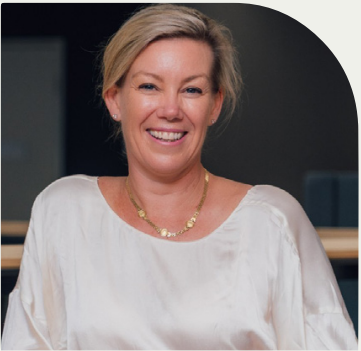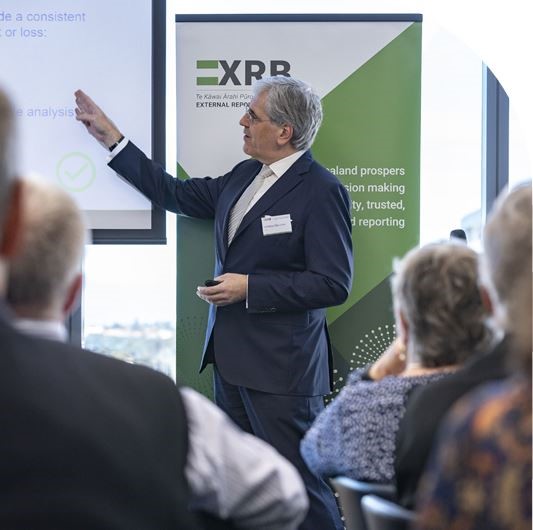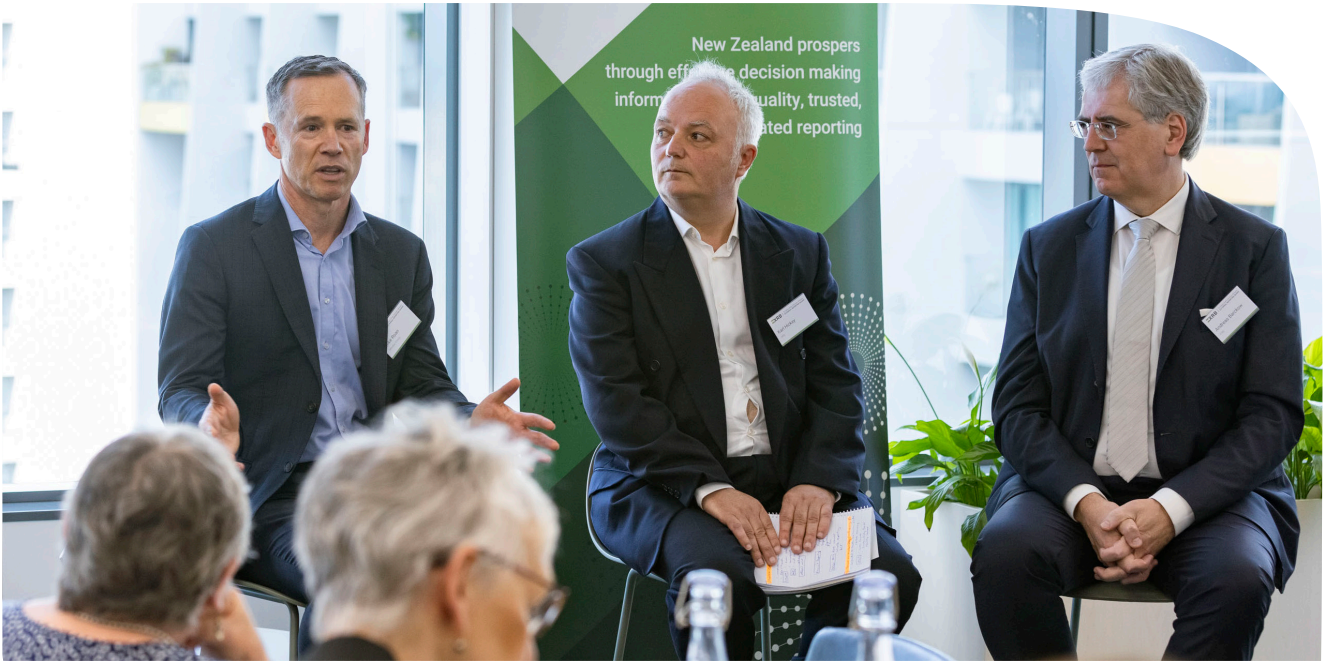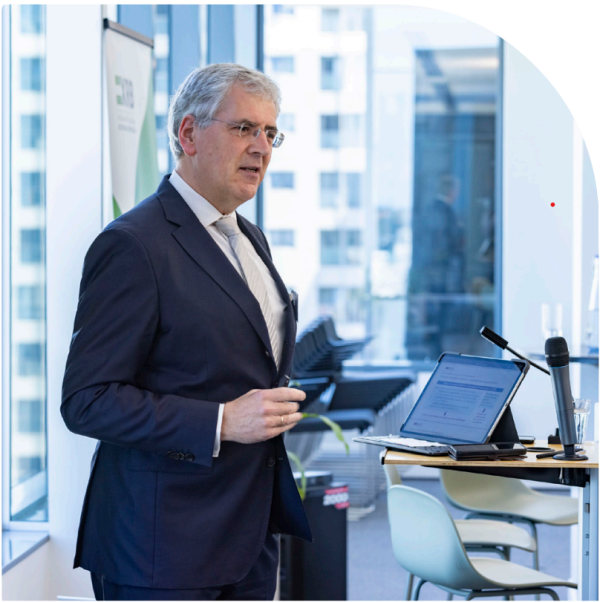Moving with the timesA lot has changed since the intangible asset standard was first introduced 25 years ago (examples include Airbnb and Spotify). Consequently, an overhaul of this standard is high on stakeholders’ wish lists. Barckow expressed his hopes that the Board may explore expanding the scope of the standard from ‘assets’ to ‘items’. Former CFO of Datacom, Rachel Walsh, says the potential for change in this area is exciting. |
“Removing the word asset would be fantastic. I look forward to seeing the outcome.”Rachel Walsh |

|
Global Financial Reporting
Balancing comparability with usability
|
At a recent CFO event in Auckland, Dr Andreas Barckow outlined the IASB’s current key projects and was joined by Mike Roan, CFO, Meridian Energy and Karl Hickey, Head of NZ Financial Governance & Policy ANZ, for a panel discussion on coherence and connectivity between financial reporting and climate-related disclosures. We also spoke with Rachel Walsh, Independent Director and David Chiang, GM Group Finance Fonterra, to get their perspectives on what Dr Barckow, had to say. Download the article here or read below. |
Dr Andreas Barckow, |

|
Typically, the IASB focuses on developing new requirements, or the general “maintenance” of standards. Every five years it consults on its work programme with the 147 jurisdictions that use them. Intangible assets and the statement of cash flows and related matters arose as research projects following the last consultation. There’s also a maintenance project to consider the climate-related risks in financial statements (later broadened to also cover other uncertainties).
And of the current projects in play, a new International Financial Reporting Standard (IFRS) is expected to be introduced in April 2024. IFRS 18 Presentation and Disclosure in Financial Statements will affect all reporting entities and will improve the information they provide about their financial performance.
In New Zealand, the XRB will play a vital role in supporting the implementation of the new standard, set to come into effect in 2027.
Financial performance - Ensuring companies ‘tell it as it is’
Better information for better decision making by investors is the purpose of the Primary Financial Statements project. The new standard, IFRS 18, will replace IAS 1 Presentation of Financial Statements, originally issued in 1975 and only marginally amended since then.
Barckow says the project will bring more rigour to the statement of profit or loss by requiring companies to present two new mandatory subtotals, being ‘operating profit’ and ‘profit before financing and tax’.
Investors have signalled that companies’ statements of profit or loss vary to such an extent that it’s hard to compare financial performance over time and between companies. These changes will address that need.
A second aspect of the new standard will introduce certain requirements when companies include so-called “Management-defined Performance Measures” (MPMs). Investors have remarked that while MPMs are useful and provide an additional data point, there’s a lack of transparency about how these measures are calculated. If an entity uses MPMs in their communication, the new IFRS 18 will require an explanation of how they reflect management’s view, why an MPM is reported, and a reconciliation back to the nearest IFRS-defined number, as well as an explanation of changes to the MPM.
David Chiang, GM Group Finance, Fonterra says it seems the IASB is listening to what investors and management want.
“It’s really good to see MPMs in there, I think that’s a great addition. There is often a healthy tension to ensure equal focus on GAAP and Non-GAAP measures in investor presentations so integrating those measures will be fantastic.”
David Chiang - GM Group Finance, Fonterra
 |
“It’s really good to see MPMs in there, I think that’s a great addition. There is often a healthy tension to ensure equal focus on GAAP and Non-GAAP measures in investor presentations so integrating those measures will be fantastic.”David Chiang |
“It’s really good to see MPMs in there, I think that’s a great addition. There is often a healthy tension to ensure equal focus on GAAP and Non-GAAP measures in investor presentations so integrating those measures will be fantastic.”David Chiang |
A third feature of the new standard covers the aggregation or disaggregation of information. Barckow says some companies don’t provide enough detailed information, or what is disclosed can be “cluttered and comingled” under the all-encompassing “other expenses” heading.
IFRS 18 will beef-up the requirements for the grouping of information, provide guidance on what should be in the primary financial statements or the notes, and on disclosures about those items labelled “other”.
Amortisation or impairment?
The IASB is also seeking to improve the data provided about business combinations at a reasonable cost. Barckow says the international market is split as to whether the current impairment-only or an amortisation approach is best, describing it as “almost a religious question” worldwide.
“Most investors don’t seem to care which method is favoured, all they want to know is to better understand “has this acquisition been a success?”
Dr Andreas Barckow
This project will see the expected synergies arising from business acquisitions to be outlined in disclosures, as well as the strategic rationale for the purchase, requiring companies to better explain to investors why they’ve entered a particular business combination. Draft decisions on the project will be published next March for consultation. Fonterra’s Chiang is pleased.
“The expected synergies in a business acquisition and goodwill being included in the disclosures is information investors and shareholders want to see.”
David Chiang
“They [investors] want to know why you’re making that acquisition. Our investors and Farmer Shareholders are always interested in how well our acquired businesses and companies are performing and this mechanism in addition to the financial performance of the business and perhaps some non-financial measures will help explain why we’ve invested in something.”
Climate-related and other uncertainties in financial statements
|
In response to stakeholder concerns that climate information in financial statements is insufficient and inconsistent with company data and commentary reported elsewhere, the IASB has a maintenance project devoted to climate-related and other uncertainties in the Barckow says the matter has received a lot of attention in international markets but stresses that the fact the word “climate” doesn’t appear in accounting standards doesn’t mean it’s not covered or can be ignored. The IASB has decided the project will be extended to cover “other uncertainties” for this very reason. The project will consider whether and, if so, how targeted amendments to improve disclosures about estimates in the financial statements could improve this reporting. Barckow says the project is also expected to clarify how to consider other long-range risks in the |
“We’re risk agnostic. IAS 1 says if a risk is substantial, it must be considered.”Dr Andreas Barckow
Dr Andreas Barckow |
“We’re risk agnostic. IAS 1 says if a risk is substantial, it must be considered.”Dr Andreas Barckow
Dr Andreas Barckow |
The financial statements are just that, for now
Attendees also heard from Chief Financial Officer of Meridian Energy, Mike Roan and Head of NZ Financial Governance & Policy at ANZ, Karl Hickey about how they integrate their reporting. Both companies undertake robust sustainability reporting. Meridian has been sharing its climate-related disclosures voluntarily for the last five years in accordance with the Taskforce on Climate-related Financial Disclosures. It also maintains a greenhouse
gas inventory.
Like other banks, the ANZ is estimating and measuring the emissions of its client base and undertakes climate reporting. It’s committed to supporting customers with their transition to lower emissions.
Barckow made it clear that the purpose of financial statements was not to inform people about how climate might or might not affect a company in the future.
“For purposes of recognising transactions and events, financial statements stop at the reporting date,” he says. “Future transactions and events are for future
financial statements.”
He points out that while it would be easy to request further disclosures with regard to how an entity has considered climate in its materiality judgements in the financial statements, there could just as readily be an argument to represent any other circumstance there in the same way - which consensually is not done.
Mike Roan says although personally he’s uncomfortable about it, Meridian Energy doesn’t currently include its climate commitments in its financial statements.
“We’re committed to halving carbon emissions within the business by 2030. That doesn’t register on the balance sheet, it would be inconsistent (with the principle of the financial statements) to do so,” he says.
Karl Hickey agrees with Roan’s personal sentiments in that reducing carbon emissions is important. He says meeting the financial statement definitions of a provision or contingent liability is key to financial statement reporting, and some entity climate commitments wouldn’t meet those definitions at present.
Rachel Walsh explains that the biggest reporting challenges faced by the organisations she supports are those around climate and there’s debate about where in reporting, climate commitments are acknowledged.
“My personal view is that an organisation’s climate activity should be included for investors so they can decide about their own personal capital allocation. Therefore, you should be including that somewhere, either quantitively or qualitatively in your annual report or integrated report,” she argues.

Mike Roan, Karl Hickey and Dr Andreas Barckow speaking at the CFO Panel Discussion
Coherence and connection
The challenges expressed by the panellists were acknowledged by Barckow.
"We have to consider how we link up financial statements with other reports,” he says.
For Climate Reporting Entities in New Zealand, The External Reporting Board’s Climate Standards include coherence as one of the principles. This requires entities to present disclosures in a way that explains the context and relationships with other disclosures so that users can make connections between the two sets
of information.
David Chiang says more integration, consistency and simplicity is needed, particularly for their end users, their farmer shareholders.
“There’s a tension between the accounting standards and the requirement for additional disclosures, ensuring they’re clear enough for non-accountants
to understand.”
David Chiang
International alignment in accounting standards enables Fonterra to compete, and Chiang says they allow true comparability with other companies. He’s encouraged by the latest changes.
The future of reporting
While remaining clear on the role of financial statements, Barckow does see change ahead, explaining that globally, regulators are seeking consistency in sustainability reporting, which prompts the question of where this information should be presented in the suite of reporting documents.
The IASB has heard that investors want reporting requirements in financial statements to remain stable. Investors then seek further information from other sources, such as management commentary or sustainability reporting, to incorporate into their analysis.
Barckow is supportive of this approach, highlighting that financial statements are just one part of the corporate reporting package available for investors.
That said, Barckow acknowledges that demonstrating linkages between the financial statements and other reports is key: “Stakeholders would no doubt benefit from showing connections between the different reports.
The IASB and ISSB are working closely to facilitate connected information between the disclosures in the financial statements and sustainability-related disclosures.”
“In the long term, when the maturity level of sustainability reporting rises and the quality of the information becomes better, then that should be looked at by a uniform board.”
Dr Andreas Barckow
Working together and using the same underlying principles and concepts in their standards should help companies to demonstrate connectivity in reporting.
In closing Barckow shared his view that in the long term, a single board undertaking the work of both the IASB and the ISSB may be an appropriate way to address corporate reporting holistically.
Read our other Insights articles here.


